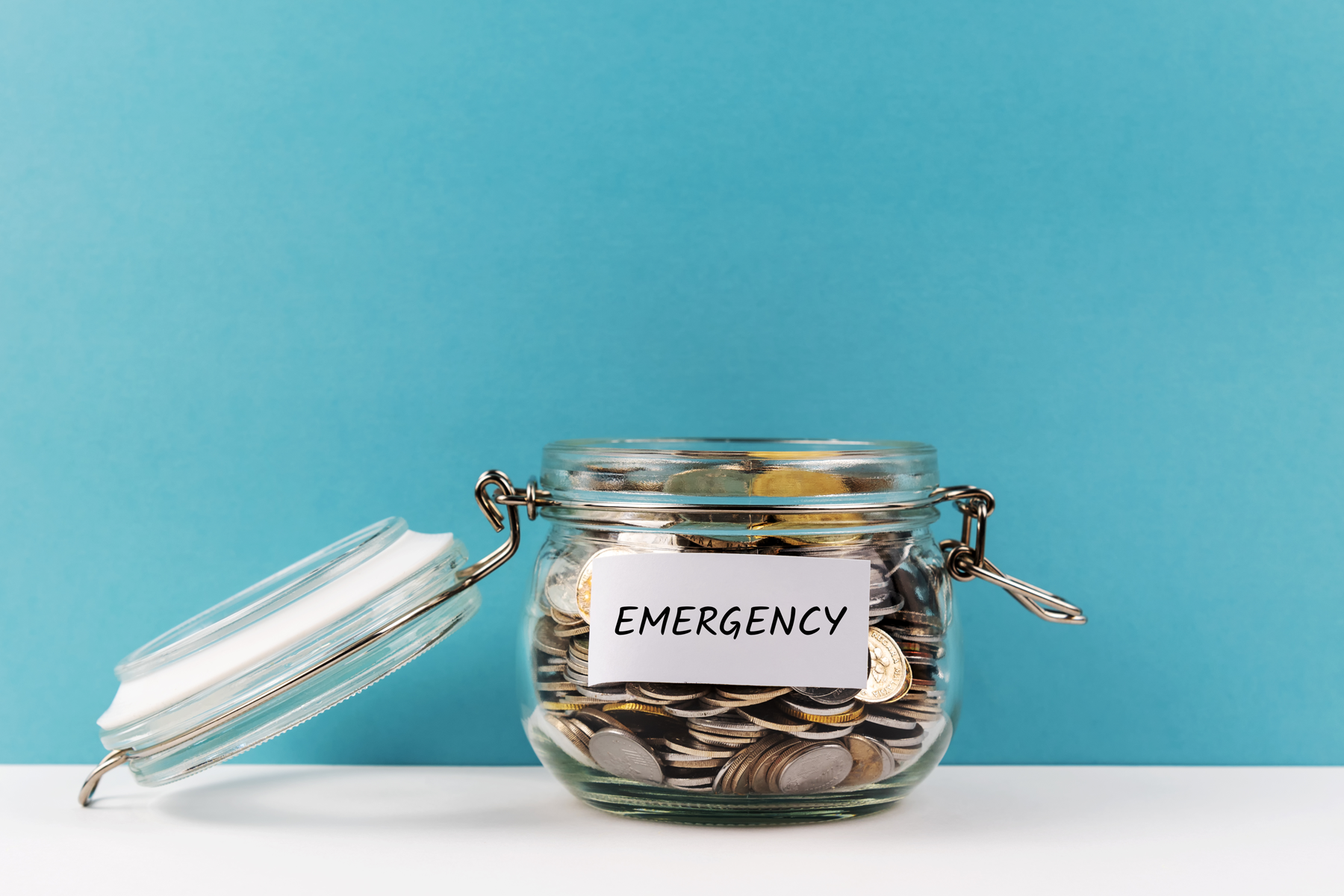Building an Emergency Fund on a Budget
I have a secret that a lot of people won’t admit. I struggle with savings. I admit, I spend money on things that I shouldn’t. I also admit that my husband is constantly giving me a meme worthy side-eye when I walk in the door with a shopping bag. I’m usually guilty of splurging on something I bought for my dog or another goopy potion to put on my face which is getting wrinklier by the day if I’m being honest. Budgeting and creating a healthy relationship with finances is hard. It’s really hard, actually. Did you know that 56% of Americans2 would be unable to cover an unexpected $1,000 expense with savings? I was once one of the millions represented in that statistic, but I realized things needed to change.
If you don’t have a savings account, what’s the best way to pay for unplanned expenses? Small financial emergencies can have a lasting impact when an emergency fund is not in place to lessen the blow, but when you’re living paycheck to paycheck, it can feel impossible to tuck away a substantial amount of financial cushion. Building an emergency fund is suggested by most financial experts, and it is considered a first step towards financial security. When you don’t have much wiggle room in the budget, how do you take the first step and start saving? Like anything else, one step at a time is the best approach. Building an emergency fund begins by building a plan. After you have a plan in place, one that includes a goal for your fund, you take one step at a time and save anywhere you can to bulk up your fund which will cover unplanned expenses. Sacrificing a few small splurges here and there can start to add up and with time a nice financial buffer can be placed between you and unforeseen expenses that can wreak havoc on your budget.
What is an Emergency Fund?
So, what is an emergency fund exactly? Is it only for emergencies? Why is it important to save money rather than spending it on things we worked hard to get? Before answering these questions, let’s take a moment to discuss what an emergency fund allows you to do. An emergency fund frees you from the worry you may feel every time your car makes a funky noise. An emergency fund provides a feeling of security that may be slightly foreign to you if you’ve never had one before.
Prior to building my first emergency fund, anything that cost more than $100 really stressed me out. There was a feeling in the back of my mind that wouldn’t go away, a feeling that said: “What if you need that money later?” I didn’t feel comfortable splurging, even when it was in the budget to do so, because I was worried something would happen that would make me regret the new clothes or shoes or whatever and wish I had the money to help pay for the issue at hand. So, what is an emergency fund? Quite simply, it is money that is set aside for emergencies.1 Yes, only emergencies. What constitutes an emergency? Not clothes or shoes or trips. Basically, any expense that is not planned but necessary can qualify as an emergency expense.
The financial stress of unexpected car repairs, medical emergencies, house repairs if you own a home, or job loss could be somewhat alleviated if you have an emergency fund. Of course, these financial emergency examples are not the only reasons to dip into the emergency fund. It’s important for you to define what an emergency means to you, create boundaries for your spending, and stick to your plan in order to reach your goals. You can do it.
Planning an Emergency Fund
When planning your emergency fund, it’s important to take stock of your current expenses and expected “unplanned” expenses. If you own a car, you will inevitably incur maintenance related expenses at some point. The same can be said about home maintenance if you own a home. Taking time to review your monthly expenses and potential liabilities is a great place to start. You’ll want to separate your expenses into fixed, or non-negotiable expenses, and flexible expenses such as entertainment, cable, and money spent on splurges like going out to eat. You’ll want to build your savings based on your monthly fixed expenses. If you lose your income or an emergency happens, keeping the mortgage or rent paid and the lights on will become the priority until your situation improves.
The commonly accepted rule of thumb for an emergency fund is to save at least six months worth of expenses.2 However, if your emergency fund is significantly lower than that, you’re in good company. Many people do not have that much in savings, but it’s never too late to get rolling towards that goal. Set aside some time soon to review and implement the following:
- Review your current monthly expenses and differentiate between flexible spending and fixed spending.
- Create a goal to save six months’ worth of fixed expenses and set a timeline for doing so.
- Create a monthly savings goal.
- Work the savings goal into your budget by cutting unnecessary spending wherever possible.
- Get rolling! Make sure to allot a bit of money each month to fun5 so that you won’t easily abandon your savings goal when things get uncomfortable.
Once you’ve determined your methods for saving, it’s time to start contributing to your emergency fund. Separating your emergency fund from your regular checking account3 is advisable because temptation can strike at any time. You do not want to choose to purchase an unnecessary item simply because you technically have the funds to cover it when you’re working towards an important goal like funding your emergency savings. Speak with your bank about the best options available to you when choosing a savings account, preferably an account that offers interest payments on savings. Make sure you can access the emergency funds when needed but make a firm rule not to touch those funds unless you’re facing a true emergency. Discipline will be your best friend as you work towards your goal.
Understanding the importance of savings does not make saving money easy, but with a plan in place it becomes more doable. One of the factors driving your ability to successfully build an emergency fund is your current income. So, what do you do when your budget doesn’t have much wiggle room and savings seems like an impossible luxury?
Building an Emergency Fund on a Budget
When you’re living on a budget, as we all should be, saving money can feel impossible. However, when considering the importance of having funds to cover a personal emergency, creative solutions that allow for saving even just a few dollars a week may be in order. As discussed, savings starts with a plan and an assessment of your current spending habits.5 Looking at your monthly spending should shed light on the areas where cutting back could be possible. Perhaps you’ll find that you’re spending $100+ a month on takeout. Maybe subscription services5 have started to add up and you can cancel a few. What do you do when the answer is less obvious?
- Review your cell phone bill with a representative and bravely ask for a discount. Promotions are sometimes available that can reduce your monthly bill.
- Opt for free forms of entertainment.
- Focus on your grocery bill. Food costs are rising. Spending time looking for coupons, discount grocers, and buying staples in bulk could be helpful.
- Evaluate transportation costs. Could you save by taking public transportation sporadically? Are you overpaying for car insurance? Would trading in your vehicle for a lower payment be an option?
Saving even a few dollars a week can add up over time and equate a six month saving plan aka a funded emergency savings account that will cover six months’ expenses. Even though saving six months of expenses may take a few years, it will be worth it. Peace of mind is much more valuable than the takeout you’ll be skipping to reach your goals. A very simple way to save a few cents at a time that can equal significant savings over time is to round up your purchases and put the change into savings.4 The easiest way to implement this method is to use cash and save the change, but that could be inconvenient since many places do not accept cash. You can tally the amount each week, but this will take quite a bit of discipline. How does this work exactly? If you spend $7.50 on a purchase, you will put .50 towards savings. No matter the method you choose, contributing to savings should be consistent. When moving monthly funds to savings, it’s easiest to make the transfers as soon as possible after receiving your paycheck. This will lessen the temptation to skip savings for the month to indulge in a splurge.
Tiny Action, Big Results
The tiniest of actions can yield big results when moving towards building a fully funded emergency savings account that will provide peace of mind when facing unforeseen expenses. Skipping coffee, opting for a happy hour with friends at your house instead of a restaurant, going for a walk instead of going shopping, all these things can add up big time over the course of just a few years. The ultimate goal is to build a fund that provides a sense of financial security. If you’ve never had an emergency fund, or if you’re still building, keep in mind that having an alternative option in your back pocket is also a plus. If you do not have an emergency fund and need quick access to cash, Cash Central offers both Payday Loans and Installment Loans. Keep in mind that borrowing money via a Payday Loan, personal loans, credit cards, and cash advances are all expensive ways to handle an emergency expense. However, Cash Central offers clear rates and terms when applying for a loan making it a great option if you decide a loan is right for your situation. Creating an emergency fund is the most cost-effective way to handle emergencies. You can create your own by completing the tiniest actions, one at a time.
* In California, deferred deposit loans are provided in accordance with the Department of Financial Protection and Innovation pursuant to California Deferred Deposit Transaction Law, Cal. Fin. Code §23000 et seq. [DG6]
Sources:
1Consumer Financial Protection Bureau – CFPB An essential guide to building an emergency fund Retrieved from: https://www.consumerfinance.gov/an-essential-guide-to-building-an-emergency-fund/#:~:text=to%20your%20inbox.-,What%20is%20an%20emergency%20fund%3F,or%20a%20loss%20of%20income
2Bennett, Karen (2022, Dec 13). How to start (and build) an emergency fund Retrieved from: https://www.bankrate.com/banking/savings/starting-an-emergency-fund/
3Burnette, Margarette (2023, Feb 17). Emergency Fund: What It Is and Why It Matters Retrieved from: https://www.nerdwallet.com/article/banking/emergency-fund-why-it-matters
4The Investopedia Team (2022, Jun 29). How to Build an Emergency Fund Retrieved from: https://www.investopedia.com/personal-finance/how-to-build-emergency-fund/
5Munk, Cheryl Winokur (2022, Oct 31). How to build an emergency savings fund during an era of inflation Retrieved from: https://www.cnbc.com/2022/10/13/how-to-build-an-emergency-savings-fund-during-an-era-of-inflation.html

 You must have JavaScript enabled to use this site.
You must have JavaScript enabled to use this site.
 For a better user experience consider upgrading your browser.
For a better user experience consider upgrading your browser.

